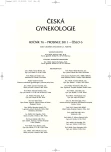Quality and effectiveness of electronic fetal monitoring
Authors:
K. Biringer; J. Danko
Authors‘ workplace:
Gynekologicko-pôrodnícka klinika JLF UK a UNM, Martin, prednosta prof. MUDr. J. Danko, CSc.
Published in:
Ceska Gynekol 2011; 76(6): 481-484
Category:
Original Article
Overview
Objective:
To evaluate effectiveness of electronic fetal monitoring methods during labor.
Design:
A case series study.
Setting:
Department of Gynecology and Obstetrics, Jessenius Faculty of Medicine, Comenius University, Martin, Slovak Republic.
Methods:
We followed 112 fetuses with simultaneous continuous monitoring (cardiotocography (CTG), intrapartal fetal pulse oxymetry (IFPO), and analysis of ST segment in fetal electrocardiogram (STAN)) during labor. We determined the effective time for every diagnostic tool. Statistics: histograms, Kolmogorov-Smirnov test, Spearman’s coefficient; significance (alfa): p<0.05.
Results:
The effective time decreased significantly in a row: CTG > STAN > IFPO (94.8%±15.1% vs. 90.4%±18.3% vs. 87.4%±21.2%). STAN was the most effective tool in the second stage of labor (91.3%±9.4%).
Conclusion:
The most effective fetal monitoring tool is CTG. However STAN is the best diagnostic method in the second stage of labor, because of its bio-signal quality.
Key words:
fetal hypoxia, cardiotocography, pulse oxymetry, STAN, electronic fetal monitoring.
Sources
1. Amer-Wahlin, I., Hellsten, C., Norén, H., et al. Cardiotocography only versus cardiotocography plus analysis of fetal electrocardiogram for intrapartum fetal monitoring: a Swedish randomised controlled trial. Lancet, 2001, 358, 9281, p. 534-538.
2. Amer-Wahlin, I., Ingemarsson, I., Marsal, K., et al. Fetal heart rate patterns and ECG ST segment changes preceeding metabolic acidaemia at birth. BJOG, 2005, 112, 2, p. 160-165.
3. Dervaitis, KL., Poole, M., Schmidt, G., et al. ST segment analysis of the fetal electrocardiogram plus electronic fetal heart rate monitoring in labor and its relationship to umbilical cord arterial blood gases. Am J Obstet Gynecol, 2004, 191, 3, p. 879-884.
4. Garite, TJ., Nageotte, MP., Porreco, R., et al. Fetal pulse oximetry (letters to the editor). Obstet Gynecol, 2002, 99, 3, p. 514-515.
5. http://www.answers.com/topic/fetal-monitoring
6. Kűhnert, M., Schmidt, S. Intrapartum management of nonreassuring fetal heart rate patterns: A randomized controlled trial of fetal pulse oximetry. Am J Obst Gynecol, 2004, 191, 6, p. 1989-1995.
7. Kwee, A., van der Hoorn-van den Beld, CW., Veerman, J., et al. STAN S21 fetal heart monitor for fetal surveillance during labor: an observational study in 637 patients. J Matern Fetal Neonatal Med, 2004, 15, 6, p. 400-407.
8. Nellcor-Puritan-Bennett. Fetal Oxygen Sensor FS-14 Series. Fetal Oxygen Sensor Placement Quick Guide. Pleasanton, CA, USA, 1995.
9. Schmidt, S., Koslowski, S., Sierra, F., et al. Clinical usefulness of pulse oximetry in the fetus with non-reassuring heart rate pattern. J Perinatol Med, 2000, 28, 4, p. 298-305.
10. Westerhuis, ME., Kwee, A., van Ginkel, AA., et al. Limitations of ST analysis in clinical practice: three cases of intrapartum metabolic acidosis. BJOG, 2007, 114, 10, p. 1194-1201.
Labels
Paediatric gynaecology Gynaecology and obstetrics Reproduction medicineArticle was published in
Czech Gynaecology

2011 Issue 6
Most read in this issue
- Use of ultrasound in labor
- Compare of misoprostol and dinoprost effectivity by induced second-trimester abortion
- Prenatal diagnosis and management of fetuses with congenital diaphragmatic hernia
- Quiscent trophoblastic disease
